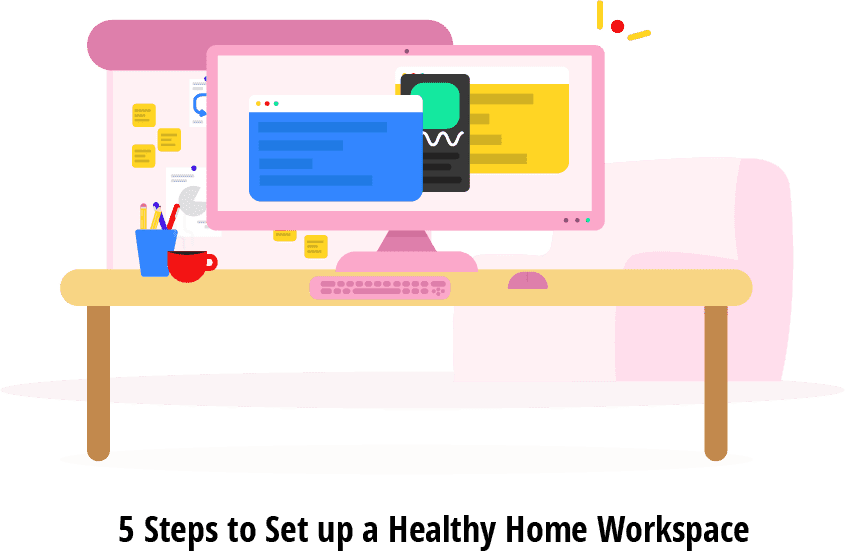5 Steps to Set up a Healthy Home Workspace
You don't need tons of extra space or money to set up a healthy home office that you love working from. Here are 5 steps to get you started.

Want to earn extra money and work from home as a transcriptionist? The right office setup can help you focus and increase your efficiency.
Transcriptionists have specific home office needs that other work-from-home jobs may not require. These include:
- Ergonomic furniture
- Good headphones and other tools
- Hand and wrist protection
Read on for some workspace inspiration to help you get started. These home office ideas can help you be more productive, reduce muscle strain, and even type faster.
1. Choose a good work from home space
Your home office space does not need to take up a whole room. Place a desk in a hallway nook, add some floating shelves to unused wall space, and you’re halfway there. Decorative pieces can make the area comfortable and stimulating, without being stifling or distracting.
The IRS permits tax deductions for home office spaces, as long as the space is used only for work, and is the principal place of business. If you intend to take a tax deduction for your home workspace, keep the IRS deduction requirements in mind when you set it up.
2. Set up an ergonomic desk
Transcription work requires you to be at a desk for extended lengths of time, so a good desk should prevent stress or pain, with a surface area large enough for all your necessary equipment and supplies.
The “correct” desk height will let you sit 20-30 inches from the computer screen. Consider a monitor stand to raise your monitor, if necessary. The healthiest choice may be a sit-stand desk, which allows you to change your posture over the course of the day.
3. Get a good desk chair
Choose an ergonomic desk chair that is easily adjustable for height, both in the seat and the back. The armrests should keep your arms at 90 degrees. The back should provide lumbar support, meaning it supports the lower back’s natural inward curve.
When seated, there should be at least 2” (or 3-4 finger widths) between the front edge of the seat and the back of your knees when you sit comfortably. If the seat is too far from or close to your knees, this could create strain or circulation issues.
Don’t want to spend money on a new desk or desk chair? Some kitchen countertops are just the right height for a standup desk. You can certainly use your existing furniture for transcription work, but make sure it lets you practice good posture and hand placement.
4. Gather the tools you will need for transcribing
To be a transcriber with Rev, you just need a few basic tools:
- Computer
- Headset
- Internet connection
- Strong English skills
However, you might want to consider other transcription equipment for best efficiency. For your computer, consider including:
- At least 4GB of RAM
- At least 15-17-inch display with matte finish (the larger the better, to protect your eyes)
- Accounting software for tracking income and hours
- External speakers
Consider adding a browser extension that lets you block specific websites. This can help cut down on distractions like Facebook or YouTube.
Other tools to consider:
- Full-size keyboard, even if you use a laptop, to keep your hands from cramping
- External hard drive for backups
- Combination printer/scanner/copier/fax
- Noise-canceling headset
- Foot pedal for digital transcription, which frees up your hands
- Standard dictionary
- Industry-specific dictionaries, depending on the transcription work
5. Protect your hands and wrists when transcribing
Carpal tunnel syndrome is common among people who spend a lot of time at the computer, but it can be reversed if symptoms are caught early. When wrists rest on desks or keyboards for long periods of time, this can compress the median nerve in the hand, causing symptoms such as aching, numbness, or tingling.
A good wrist brace (or two) can encourage correct wrist positioning and reduce the risk of injury, even if you don’t wear it all the time. Some transcriptionists choose to wear special gloves instead of a brace, as long as they do not interfere with your ability to type.
It’s a good idea to take frequent breaks to stretch, walk around, or perform other tasks. Consider keeping hand exercise tools on or near your desk to make these breaks easier. This might be a stress ball, therapy putty, hand grip strengtheners, or even a few Legos!
The Takeaway
Home office setup doesn’t have to be intimidating, complicated, or costly. Choose a convenient space that helps you focus, gather the necessary equipment, and be sure to protect yourself from strain and injury.
When you’re ready to go, apply today to become a Revver.
Learn more about human transcription
Subscribe to The Rev Blog
Sign up to get Rev content delivered straight to your inbox.



